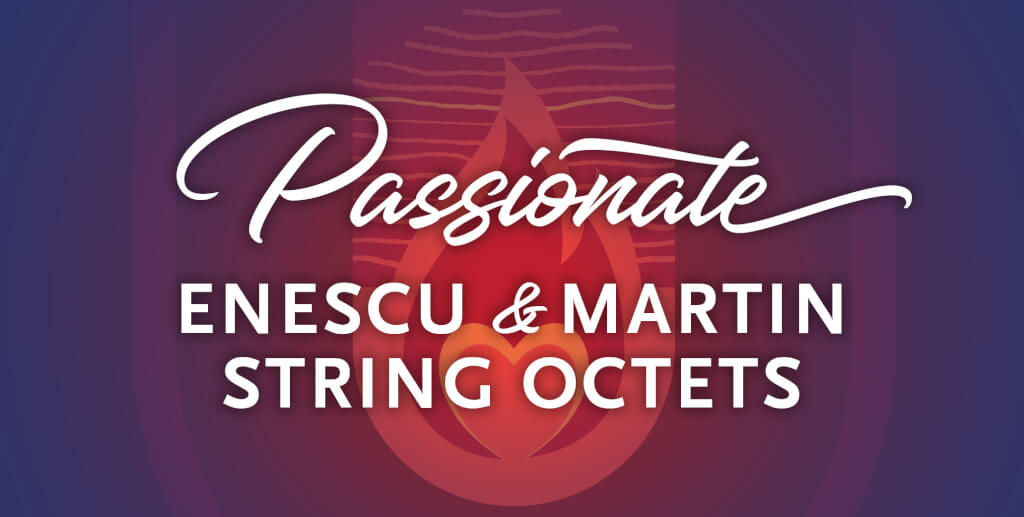Chamber Concert
Sunday, March 5, 2023, 3:00 p.m.
The War Memorial, 32 Lake Shore Dr, Grosse Pointe Farms, MI 48236


Sunday, March 5, 2023, 3:00 p.m.
The War Memorial, 32 Lake Shore Dr, Grosse Pointe Farms, MI 48236
Join us on March 5, 2023, at The War Memorial in Grosse Pointe Farms for the chamber music concert “Passionate Enescu: & Martin String Octets” featuring compositions by George Enescu as well as a commissioned work by American composer Colin Martin.
Colin Martin (b. 1993)
Amerikinetics for String Octet (2023)
I. Very fast, with country spirit
II. Slowish, jazzy
III. Fast, with big city energy
INTERMISSION
George Enescu (1881–1955)
Octet for Strings, Op. 7 (1897)
I. Très modéré
II. Très fougueux
III. Lentement
IV. Mouvement de valse ben rythmée
Amerikinetics (2023)
Program Note by Colin Martin
“Amerikinetics” is a portmanteau of “American” and “kinetics,” meaning the study of motion. It refers to the lively American rhythms that serve as the basis of the entire work and give it a sense of propulsive movement. The first movement, “Very fast, with country spirit,” is largely in 10/8 time and evokes fiddle/bluegrass music of the American south. The second movement, “Slowish, jazzy,” relies on a swing rhythm to produce a seductive nocturne. The third movement, “Fast, with big city energy,” features a syncopated, propulsive rhythm that evokes the energy of America’s lively major cities. A hectic, polytonal middle section in mixed meter evokes the sometimes-chaotic nature of city life. I’d like to extend my thanks to the American Romanian Festival for this commission and for giving me the opportunity to compose this invigorating piece.
Octet for Strings, Op. 7 (1899–1900)
Program Note by David B. Levy
Romanian composer, violinist, conductor, and educator George(s) Enescu was born on August 19, 1881, in Liveni-Vîrnav (later renamed “George Enescu”) in the old Kingdom of Romania and died in Paris on May 4, 1955. His first name acquired an added “s” in France. There is no disagreement that Enescu was the most gifted musician ever to emanate from his native Romania. His impact on contemporaneous Romanian musicians and subsequent generations remains strong even today, and his ability to retain a vast repertory of music in his memory was prodigious. Enescu’s influence, however, was truly international in scope, earning him praise of musicians from across the globe. As a teacher of violin, Yehudi Menuhin, Ivry Gitlis, Arthur Grumiaux, and Ida Haendel were among his most illustrious students. His activity as a conductor was widespread, having especially been active in Paris and New York, where he came under consideration as the successor to Arturo Toscanini as music director of the New York Philharmonic in 1936. As a composer, Enescu is best known for his two Romanian Rhapsodies, whose popularity have overshadowed his other compositions, much to the composer’s annoyance. His Octet for Strings was composed between 1899 and 1900, and its first performance took place on December 18, 1909, in the Salle des Agriculteurs in Paris, as part of a festival concert of Enescu’s chamber works in the Soirées d’Art concert series. The performers were the combined members of the Géloso and Chailley Quartets. The Octet is dedicated to André Gedalge, a composer and educator whose students included Enescu, Charles Koechlin, and Maurice Ravel.
Enescu’s Octet for Strings proudly takes its place as one of the masterworks of the rich repertoire of string chamber music. According to the biographical article on the composer in the New Grove Dictionary of Music and Musicians, “melodic line was, for Enescu, the vital principle of music: as he wrote in his autobiography, ‘I’m not a person for pretty successions of chords … a piece deserves to be called a musical composition only if it has a line, a melody, or, even better, melodies superimposed on one another.’” This principle certainly applies well to the Octet, a piece whose first movement offers the listener no fewer than six melodies, or melodic ideas, all of which inform the events of its vast four-movement canvas. Speaking of his year-and-a-half-long work on the 40-minute piece, Enescu is quoted as having said, “I wore myself out trying to make work a piece of music divided into four segments of such length that each of them was likely at any moment to break. An engineer launching his first suspension bridge over a river could not feel more anxiety than I felt when I set out to darken my paper.”
The most famous string octet in the repertory, of course, is the wonderfully exuberant Op. 20, composed by the young Felix Mendelssohn when he was a mere 13 years old. Enescu was not too far behind his predecessor, having finished his Octet when he was only 19. An accomplished violinist, the Romanian master certainly knew how to exploit the full range of possibilities in writing for string instruments. The Octet certainly taxes the virtuosity of its performers. Even more, it reveals Enescu’s considerable skill as a master of color and counterpoint. Having lived in Vienna and Paris, he was also keenly attuned to the styles of his contemporaries, including Gustav Mahler and Claude Debussy. While the influence of these styles is occasionally discernible by listeners familiar with those idioms, the Octet retains its own palpable freshness and originality. The four movements are titled (in French): Très modéré, Très fougueux (ardent), Lentement, and Mouvement de Valse bien rythmée. This final movement is, indeed, a true fin de siècle tour de force, whose wildly frantic final measures could be seen as a precursor to Ravel’s symphonic poem La valse.